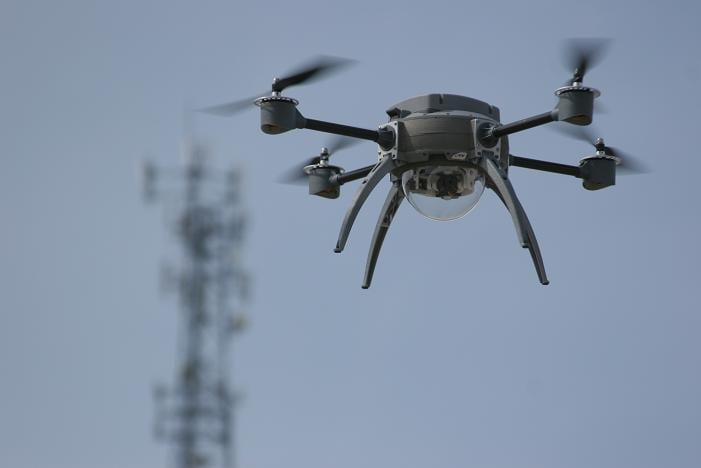[Avionics Today 10-15-2014] The European Commission, like many government agencies across the globe, is racing to regulate airspace for civil Unmanned Aircraft Systems (UAS) as quickly as technology and business opportunities in the sector are developing. The European Commission is endorsing and overseeing a SESAR JU-led “Definition Phase” aimed at aligning civil UAS regulations with ongoing Air Traffic Management (ATM) Research and Development (R&D) requirements for manned aviation with the SESAR 2020 implementation program with the hopes of accommodating the growing UAS community.
 |
| A civil UAS. Photo: WIkipedia |
The implementation European RPAS Roadmap, published by the European Commission, calls for initial integration of civil UAS by 2016, but even the members and stakeholders involved in the SESAR partnership don’t know if it’s possible to get the burgeoning technology on track with the rest of implementation.
“Integration will follow a progressive path towards full integration as laid out in the European roadmap. It’s hard to say if when we’re going to be fully integrated as areas require R&D and validation towards industrialization. It’s hard to say if we’re going to be fully integrated with everything by 2020 or 2025,” said Michael Standar, chief of strategies and international relations at SESAR JU, told Avionics Magazine. Standar believes that the timing of integration depends on the type of operations for civil UAS.
“If it’s very low level operations, below 500 feet and within visual line of sight, then that is already happening.”

When it comes to airspace classes, integration becomes more of an issue around busy hubs of manned aviation, such as airports, where there needs to be a highly structured application of technology. In many places in Europe, as with the FAA’s recent approval of UAS for use in film production, operations below 500 feet are already in operation. But beyond low-level UAS, there’s still much to be determined.

“Operations operating beyond visual line of sight will need capabilities, such as communication links and systems for detect and avoid which currently need to be evaluated and validated and that will take a larger piece of R&D and validations before deemed ready for operations,” Standar says. “In some airspace classes RPAS are already in place and will continue to operate under certain conditions but when it comes to operating in controlled airspace together with manned aviation there is still more work to be done on capabilities and how to apply them.”

As of now, they don’t have those capabilities. Operators and researchers see this disconnect with developing technology as well. According to Antidio Viguria head of avionics and UAS at ATLAS flight test center, Spain’s first facility exclusively devoted to testing technologies and light UAS, many are looking to the government agencies to fill these technology and legislation gaps. 

“Sense and avoid (or Detect and Avoid) is still a major issue for the integration of UAS in the non-segregated airspace. The challenge is even greater for light [Remotely Piloted Aircraft Systems] RPAS (less than 150Kg MTOW) since the payload capacity is much more reduced in this category … The sense and avoid issue is a major problem that will need some years of R&D to start getting closer to an operational solution. In this sense, it is fundamentally the contribution of the [European Commission] EC and national governments that have the power to support this basic activity,” said Viguria during an interview with Avionics Magazine.
Business opportunities for civil UAS are on the rise throughout Spain, including surveillance, prevention of brush fires, inspection of field crops in agriculture, among others, but the researchers believe there is still much work to be done not only in the areas of sense-and-avoid, but also with communications and GPS navigation.
“The communication systems and transponders need to be further developed and adapted to the special needs of the UAS and its operations. The strong dependency of GPS with the navigation system of light UAS is also an issue when safety requirements start to be considered,” Viguria added, noting that technological developments in these and other areas are continuing to make UAS more affordable, driving business opportunities.
While technical issues are prevalent for UAS, Standar maintains that technology is not the only issue. Instead, harmonizing rules for airspace is going to be a much larger challenge.
“One of the main hurdles here is to get the large community of RPAS operators to understand the notion of operating in the airspace together with other traffic. There are very homogenous groups inside aviation — airlines, business aviation, general aviation, all these are familiar with the rules of the game. Here we have a completely new community of people that do things because it’s connected to a business value in an area where we’ve never experienced aviation as such,” he said.

And on top of the new community that civil UAS have created is the old problem of uniting all European countries under one set of regulations.

“The issue sits more with the fact that 15 countries have RPAS regulations in place and there are areas in which a European harmonization would be needed and beneficial to avoid any unnecessary differences as to how regulations are applied as well as to avoid unnecessary bureaucracy,” Standar said.

It’s not just the dozens of European countries that SESAR JU has to work with, but the European Commission is reaching across the pond as well to attempt to coordinate with the FAA’s application of NextGen.
“It is of the utmost importance that we work together and harmonise on the international scene,” Standar said. “Not the least with the U.S. /FAA. We do have a coordination plan for this purpose under the EU-US Memorandum of Cooperation SESAR/NextGen.”